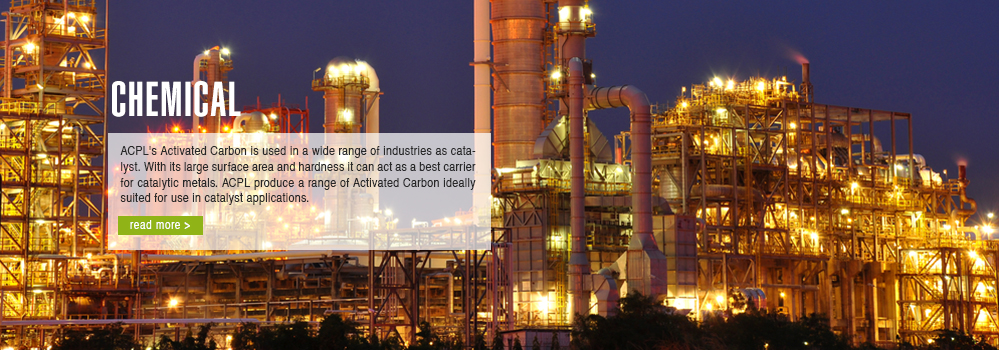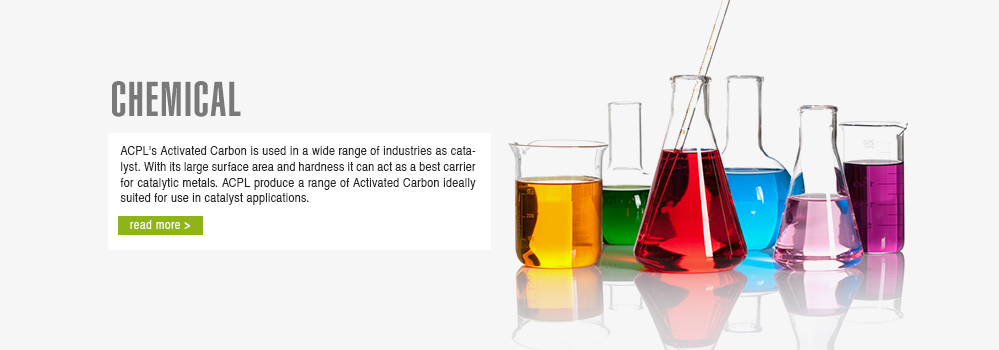ACPL's Activated Carbon is used in a wide range of industries as catalyst and catalyst support. With its large surface area and hardness it can act as a best carrier for catalytic metals. ACPL produce a range of Activated Carbon ideally suited for use in catalyst applications.
Scope of Applications of AC:
- Chlorination of hydrocyanic acid to cyanogens chloride and cyanuric chloride
- Glyphosate production as oxidation catalyst
- Merox process in mercaptan removal in petroleum refineries
- Production and destruction of Phosgene
- Conversion of sulfur dioxide to sulfur trioxide
- Precious metal catalyst carrier in pharmaceutical and chemical industry.

Catalysts are used in the chemical industry. Catalysts can be grouped into two according to the state. Homogenous catalyst is used in the solution state and Heterogeneous catalyst is used in the solid state. Activated Carbon is used as catalyst support to prepare heterogeneous catalyst. Activated carbon is used to increase the surface area of the heterogeneous catalyst. It is a good catalyst support to improve aeration, heat resistance and anti-poisoning. The Carbon is virtually inert and hence does not interfere with the main reaction In heterogeneous catalyst the reactions are carried out on the surface of the catalyst. To increase the activity of the catalyst surface area of the catalyst should be increased. When metals like palladium, platinum are used as catalysts, they are pulverized and distributed on the porous structure of activated carbon used as catalyst support. Due to the high surface area of Activated Carbon the reaction efficiency of the catalyst is increased.
Activated Carbon catalyst support is useful to increase aeration during catalyst reaction. This prevent local over heat due to the heat of reaction. Catalysts are used for high temperature reactions. When activated carbon is used as catalyst support, loss of surface area doesn't occur due to the exclusion of oxygen and water in high temperature. Activated Carbon as a catalyst support can withstand high pressure reactions without structural deterioration.
Activated Carbon can be used as catalyst. It is used for gas-solid reactions since they are catalytically active due to their unique surface characteristic.
- Dehydrogenating Reaction
- Oxidation Reaction
- Dehalogenation Reaction
- Halogenation Reaction
- Oxidation dehydrogenating reaction

All the pdfs are password protected. To know the password kindly contact us at ea@activechar.com

In many industries like printing industry, dry cleaning industry and paint industry many types of solvents are vaporized in the course of production process. Recovery of these solvents from the exhaust air is a good practice in order to reduce cost and atmospheric pollution. In this process the activated carbon adsorbs the solvent from the air and subsequently desorbs by hot steam or inert gas. The condensate then treated to recover the solvent for reuse. The efficiency of solvent recovery depends on the pore structure of the activated carbon.
Activated Carbon is capable of recovering acetone, cyclohexane, carbon disulphide, toluene and methyl-ethyl ketone.

All the pdfs are password protected. To know the password kindly contact us at ea@activechar.com



Please remember to mention your contact details so that we can serve you better.




